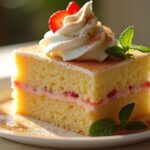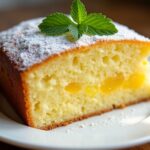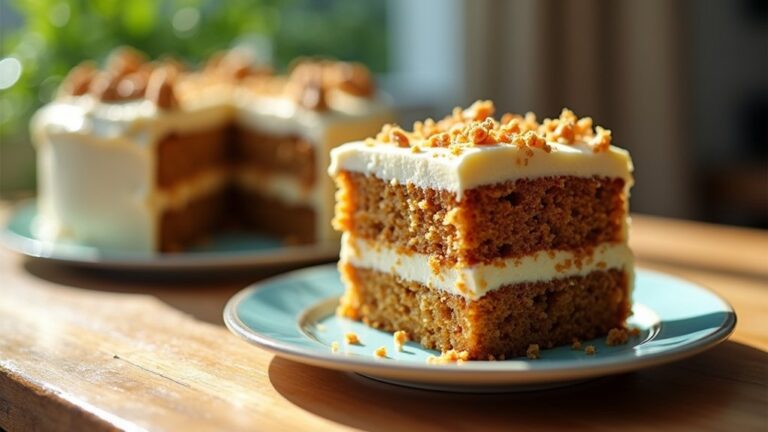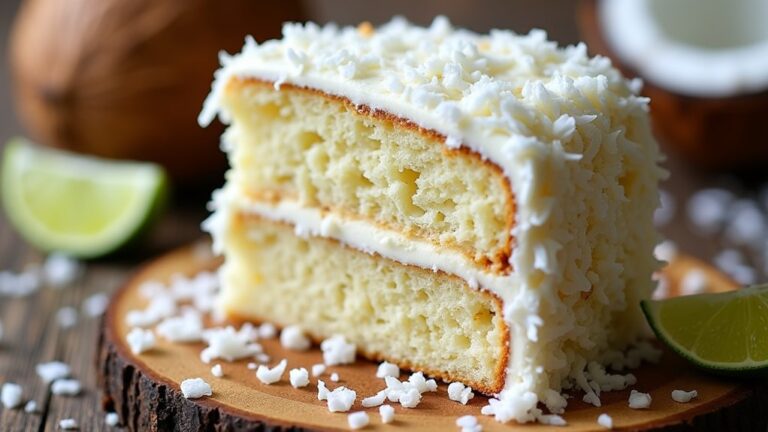Milk Cake Recipe
I can’t wait to share my milk cake recipe with you! This traditional Indian dessert is made with just a few ingredients: full-fat milk, sugar, and cardamom, combined to create a rich, creamy delight. It’s perfect for celebrations and can be garnished with nuts for extra flavor. Imagine the joy of serving this sweet treat to family and friends! Stick around to discover more about its history, nutritional benefits, and creative serving suggestions.
Contents
History
When I first learned about milk cake, I was fascinated by its rich history that stretches back centuries. This delightful treat, known as “kalakand,” has roots deeply embedded in Indian desserts, often celebrated during festivals and special occasions. Its origins trace back to the Indian subcontinent, where it symbolizes joy and togetherness. The process of making milk cake showcases traditional culinary techniques, reflecting the innovation of ancient artisans who transformed simple ingredients into something extraordinary. As I explored its cultural significance, I discovered that milk cake isn’t just a dessert; it represents the essence of celebration, connecting generations and communities through shared flavors. Understanding this history added a layer of appreciation for this beloved confection that I now cherish.
Recipe
Milk cake, also known as kalakand, is a delectable Indian sweet that is loved for its rich taste and tender texture. Made primarily from fresh milk and sugar, this dessert is often enjoyed during festivals and special occasions. The preparation of milk cake is a simple yet rewarding process that results in a treat that melts in your mouth. With its sweet, creamy flavor and slightly grainy texture, milk cake is sure to impress your family and friends.
To create the perfect milk cake, it’s vital to use fresh, high-quality ingredients. The key component is the milk, which needs to be curdled and then cooked down to achieve the desired consistency. The addition of cardamom and nuts not only enhances the flavor but also adds a delightful crunch. With just a few steps, you can whip up this delightful dessert that’s bound to become a favorite in your household.
Ingredients:
- 1 liter full-fat milk
- 2 tablespoons lemon juice or vinegar
- 1 cup sugar
- 1/4 teaspoon cardamom powder
- 2 tablespoons ghee (clarified butter)
- Chopped nuts (almonds, pistachios) for garnish
To prepare the milk cake, boil the milk in a heavy-bottomed pan and stir continuously to prevent it from sticking. Once it comes to a boil, add the lemon juice or vinegar to curdle the milk. Stir gently until the whey separates from the chenna (curds). Strain the chenna through a muslin cloth and rinse it under cold water to remove the sourness. Squeeze out excess water and then transfer the chenna back to the pan. Add sugar, cardamom powder, and ghee, and cook on low heat while stirring continuously until the mixture thickens and starts to leave the sides of the pan. Once done, spread the mixture onto a greased plate, flatten it, and let it cool. Cut into pieces and garnish with chopped nuts before serving.
When making milk cake, make certain that the milk is fresh and not overly boiled, as this can affect the texture of the final product. It’s also important to keep stirring the mixture while cooking to prevent burning, and to achieve a smooth consistency. If you prefer a slightly different flavor, feel free to experiment with adding a hint of saffron or rose water. Finally, allow the milk cake to cool completely before cutting it into pieces for the best presentation and taste. Enjoy your homemade milk cake!
Cooking Steps
Now that we’ve gathered all the ingredients, I can’t wait to share the cooking steps that bring this milk cake to life. First, I mix the milk and sugar, letting the sweet aroma fill the kitchen as I cook it on low heat. Adding cardamom and nuts at just the right moment transforms this treat into something truly special before pouring it into a greased tray to set.
Step 1. Gather All Ingredients
Gathering all the essential ingredients is the first step toward creating a delicious milk cake. I like to start by collecting my ingredient types, which include full-fat milk, sugar, ghee, lemon juice, and cardamom. For the perfect texture, I measure 1 liter of milk, 200 grams of sugar, and 50 grams of ghee. Don’t forget a pinch of cardamom for that aromatic kick! The lemon juice, about 2 tablespoons, is vital for curdling the milk. Once I’ve laid everything out, I make sure that my measuring cups and spoons are ready. This preparation not only streamlines the process but also sparks creativity! With the right ingredient measurements in hand, I’m set to transform these components into a delightful treat.
Step 2. Mix Milk and Sugar
Start by pouring the measured full-fat milk into a heavy-bottomed saucepan. The milk’s rich properties will create a creamy base for our cake. Next, I add sugar, opting for a mix of granulated and brown sugar. The granulated sugar dissolves quickly, while the brown sugar lends a subtle caramel flavor that enhances the overall taste. As I stir, I feel the smooth texture of the milk blending seamlessly with the sugars. It’s fascinating how the combination not only sweetens but also transforms the mixture, creating a luscious syrupy consistency. This step is essential, as it sets the foundation for our milk cake’s delightful sweetness. Once combined, the anticipation of the cooking process begins to build!
Step 3. Cook on Low Heat
As the mixture begins to simmer, I lower the heat to a gentle setting, ensuring that the milk cooks slowly and evenly. This slow simmer is essential; it allows the flavors to meld beautifully while preventing any scorching. I watch closely, stirring occasionally to keep everything moving and to avoid any pesky lumps. The gentle heat transforms the milk, thickening it gradually into that luscious base we crave. It’s mesmerizing to see the texture change, as patience pays off in this process. I take a moment to savor the sweet aroma filling my kitchen, knowing that good things come to those who wait. So, let’s embrace this tranquil cooking phase; it’s where the magic truly begins.
Step 4. Add Cardamom and Nuts
Once the milk has thickened to a creamy consistency, I reach for the fragrant cardamom pods and a handful of chopped nuts. I love using a mix of almond, pistachio, and cashew varieties for their unique textures and flavors. As I crush the cardamom pods, their aromatic essence fills the air, reminding me of the spice’s numerous benefits—like aiding digestion and boosting immunity. I sprinkle the crushed cardamom and nuts into the warm milk mixture, stirring gently to combine. The nuts not only add a delightful crunch but also enhance the nutritional profile of the cake. This step infuses the dessert with warmth and complexity, setting the stage for a truly innovative treat that’s both rich and wholesome.
Step 5. Pour Into a Greased Tray
Gently pouring the thickened milk mixture into a greased tray feels like the final act of a heartfelt performance. As I angle the tray just right, I use deliberate pouring techniques, allowing the creamy goodness to flow smoothly and evenly. The greased surface glistens, creating a perfect backdrop for my creation. I take a moment to appreciate the aroma wafting up, a blend of cardamom and nuts that’s simply irresistible. While pouring, I make sure there are no air bubbles, which could disrupt the cake’s texture. Once the mixture fills the tray, I give it a gentle shake to level it out. This step is essential for achieving that perfect finish. Now, it’s time to let it set and transform into a delightful treat!
Nutritional Guide
While indulging in a delicious milk cake, it’s important to take into account its nutritional aspects. This sweet treat can offer surprisingly delightful health benefits, provided we enjoy it in moderation. Here’s a quick nutritional overview:
| Nutrient | Amount per Serving |
|---|---|
| Caloric Content | 250 calories |
| Protein | 5 grams |
| Sugars | 30 grams |
Milk cake’s caloric content can vary, but it mainly provides energy from carbohydrates. The milk and sugar contribute essential nutrients like calcium and vitamin D, which can support bone health. So, next time you savor a slice, remember that it can be part of a balanced diet when consumed wisely!
Final Thoughts
Reflecting on the nutritional guide for milk cake, it’s clear that this delightful dessert can be enjoyed without guilt when eaten mindfully. I love how versatile milk cake is, allowing for endless taste variations. You can infuse it with cardamom, saffron, or even a hint of citrus zest for a unique twist. When it comes to serving suggestions, consider pairing slices with fresh fruits or a drizzle of honey for added sweetness. You might even serve it alongside a scoop of vanilla ice cream for a luxurious treat! Whether you’re entertaining guests or indulging in a quiet moment, milk cake proves to be a wonderfully innovative dessert that satisfies cravings while remaining a thoughtful choice. Enjoy your culinary adventure!
Frequently Asked Questions
Can I Use Non-Dairy Milk for This Recipe?
I’ve experimented with non-dairy options like almond or oat milk, and they work beautifully as milk substitutes. Just keep in mind that the flavor and texture might vary slightly, but it’s definitely worth trying!
How Long Does Milk Cake Stay Fresh?
Imagine savoring a slice of sweetness, but how long does it last? Milk cake boasts a shelf life of about five days. For freshness, I store it in an airtight container, away from sunlight.
What Are Common Variations of Milk Cake?
When I think about variations, chocolate milkcake always excites me, blending rich flavors. I also love adding fresh fruit toppings for a vibrant twist, creating a delightful balance that elevates the classic experience. Enjoy experimenting!
Can I Freeze Milk Cake for Later Use?
I once froze a dessert for a party, using airtight storage containers and smart freezing techniques. You can absolutely freeze milk cake! Just make certain it’s wrapped well to maintain its deliciousness. Enjoy later!
What Equipment Do I Need for Making Milk Cake?
When I make cakes, I rely on a sturdy stovetop for cooking and versatile cake molds to shape the batter. These tools elevate my baking game, ensuring delicious results and creative presentations every time.
Conclusion
In the end, making milk cake is more than just a recipe; it’s a delightful experience, a journey through flavors, and a celebration of tradition. As I savored each bite, I felt the warmth of nostalgia and the joy of sharing something special. So, gather your ingredients, embrace the process, and create your own sweet memories. Whether for a family gathering or a quiet afternoon treat, milk cake brings happiness to every moment it graces.








